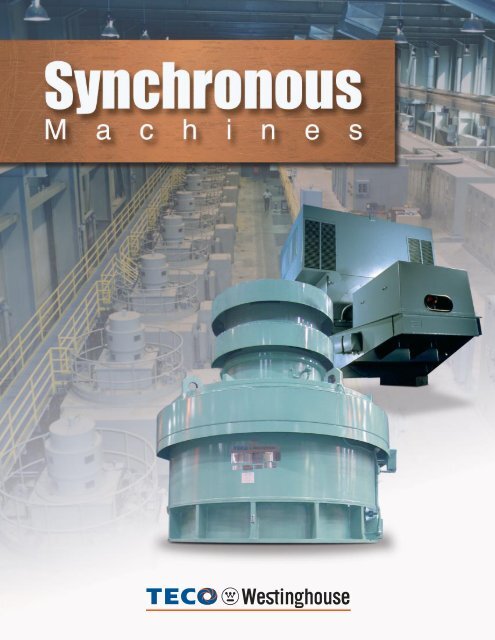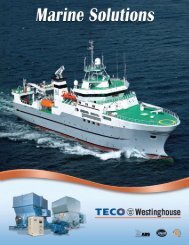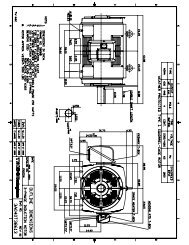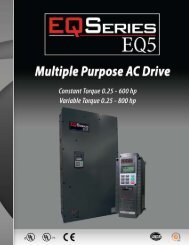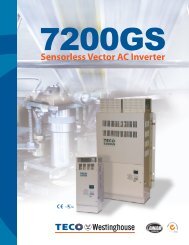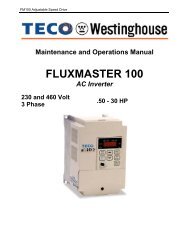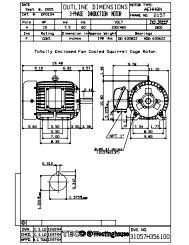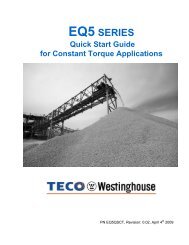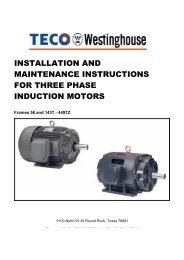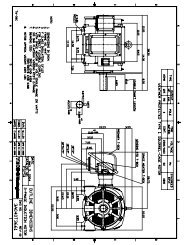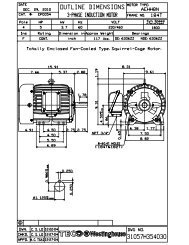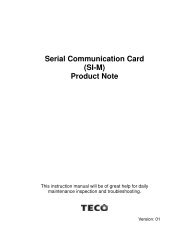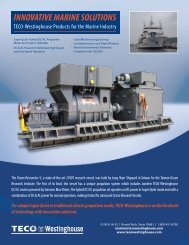Synchronous Brochure - TECO-Westinghouse Motor Company
Synchronous Brochure - TECO-Westinghouse Motor Company
Synchronous Brochure - TECO-Westinghouse Motor Company
You also want an ePaper? Increase the reach of your titles
YUMPU automatically turns print PDFs into web optimized ePapers that Google loves.
<strong>TECO</strong>-WESTINGHOUSE<br />
MOTOR COMPANY<br />
SYNCHRONOUS<br />
MACHINES<br />
<strong>TECO</strong>-WESTINGHOUSE EXPERIENCE:<br />
ASSURING SUPERIOR PERFORMANCE<br />
AND RELIABILITY<br />
For over a century, <strong>Westinghouse</strong> has been the<br />
pacesetter in the design and production of electric<br />
machines for heavy industry. This tradition is carried<br />
forward by <strong>TECO</strong>-<strong>Westinghouse</strong> <strong>Motor</strong> <strong>Company</strong>.<br />
Our engineering, design expertise, rigorous<br />
quality control, and testing procedures ensure the<br />
superior performance and unsurpassed reliability of<br />
each machine.<br />
Since the late 19th century, <strong>Westinghouse</strong> has<br />
been the driving force behind the evolution of<br />
rotating electric machine technology. The long list of<br />
pioneering developments includes Vacuum Pressure<br />
Impregnation (VPI), Thermalastic® Epoxy insulation,<br />
self-lubricating bearings and brushless excitation.<br />
In the synchronous arena, <strong>TECO</strong>-<strong>Westinghouse</strong><br />
<strong>Motor</strong> <strong>Company</strong> has a track record for excellence<br />
and innovation.<br />
Designed to meet the needs of both domestic<br />
and worldwide motor markets, <strong>TECO</strong>-<strong>Westinghouse</strong><br />
<strong>Motor</strong> <strong>Company</strong> synchronous machines are the<br />
culmination of more than 100 years of<br />
experience from the acknowledged leader in<br />
rotating electric machine technology.<br />
1<br />
SYNCHRONOUS MACHINES:<br />
THE OPTIMAL CHOICE<br />
FOR HEAVY INDUSTRY<br />
<strong>TECO</strong>-<strong>Westinghouse</strong> <strong>Motor</strong> <strong>Company</strong> synchronous<br />
motors and generators provide superior value with<br />
proven reliability, low maintenance performance and<br />
long life in arduous applications. Our synchronous<br />
machines offer numerous benefits including:<br />
❙ Constant-speed operation<br />
❙ High efficiency ratings<br />
❙ Low inrush currents<br />
❙ Leading power factor (for corrective<br />
KVA capability)<br />
These features make synchronous machinary the<br />
optimal choice for many industrial drive applications.<br />
<strong>Synchronous</strong> motor efficiencies are higher than those<br />
of induction motors. Their inrush currents are low and<br />
they can be designed with torque characteristics to<br />
meet the requirements of the driven load and<br />
available power supply. Starting, pull-in and pull-out<br />
torques can be selected over a wide range, and for short<br />
time periods the pull-out torque can even be increased<br />
by field forcing without affecting any other<br />
performance characteristics.<br />
In general, synchronous motors have less of a system<br />
voltage drop during start-up than induction motors.<br />
Power factor improvement is one of the most attractive<br />
considerations in selecting a synchronous machine.<br />
<strong>Synchronous</strong> motors operate at leading power factors<br />
and are typically available with rated power factors<br />
ranging from unity to 0.80 leading. Thus they can<br />
produce substantial savings by supplying reactive<br />
power to counteract lagging power factor caused by<br />
other inductive loads. <strong>Synchronous</strong> condensers are<br />
offered as a reliable alternative to power factor<br />
capacitor systems.<br />
1<br />
Municipal Clearwater<br />
Pumping Facility - (12)<br />
6000 HP Vertical<br />
<strong>Synchronous</strong> Variable<br />
Frequency Drive<br />
<strong>Motor</strong>s, up to 450 RPM
SYNCHRONOUS APPLICATIONS<br />
<strong>TECO</strong>-<strong>Westinghouse</strong> <strong>Motor</strong> <strong>Company</strong> synchronous<br />
machines are customized to the specific<br />
requirements of each application. Because of their<br />
unique features, high operation efficiencies and<br />
adaptability to all working environments, synchronous<br />
motors and generators are the logical choice for<br />
a multitude of industries. These industries include<br />
the pulp, paper processing, electric utility, marine,<br />
water processing treatment, waste water treatment,<br />
chemical, petrochemical, steel, mining, cement,<br />
air conditioning and air separation industries.<br />
<strong>Synchronous</strong> motors can be found wherever there is a<br />
demand for highly efficient, cost-effective, dependable<br />
machines. They are frequently used for chippers,<br />
mixers, crushers, pulverizers, rolling and grinding mills,<br />
pulp refiners, pumps, fans, and compressor drives, as<br />
well as adjustable-frequency drive equipment. With all<br />
of the advancements made in adjustable frequency<br />
drive technology, the variable speed synchronous<br />
motor is a logical choice for applications requiring high<br />
torque at low speed with a wide speed range.<br />
Because of the higher efficiency, smaller size and<br />
higher output capability, the synchronous motor is<br />
replacing the DC motor as the driver in high<br />
performance applications.<br />
<strong>Synchronous</strong> generators can be found in any number of<br />
applications, including gas, hydro, wind and turbo<br />
expansion systems.<br />
<strong>Synchronous</strong> condensers are available to provide a local<br />
grid system with necessary KVARS required to balance<br />
highly inductive loads, there by reducing power<br />
company imposed demand charges and power<br />
factor penalties.<br />
1<br />
Refinements to<br />
process and designs<br />
have led to the<br />
development of<br />
smaller, more efficient<br />
synchronous motor<br />
1<br />
FEATURES FOR EFFICIENT PERFORMANCE<br />
<strong>TECO</strong>-<strong>Westinghouse</strong> <strong>Motor</strong> <strong>Company</strong> synchronous<br />
machines feature high efficiency designs in which great<br />
care is taken to minimize losses. To ensure maximum<br />
operating efficiencies and trouble-free operation,<br />
the following features are standard:<br />
❙ Airgap, slot openings and slot ratios are selected<br />
to reduce pole face losses due to flux pulsations.<br />
❙ Low loss, core-plated, non-aging, silicon steel<br />
stator punchings are used to reduce core losses.<br />
❙ The stator copper is stranded to minimize<br />
eddy current losses.<br />
❙ The number of stator slots, slot width, slot depth<br />
and stator core depth are dimensioned to reduce<br />
magnetic noise.<br />
❙ Pole punchings are designed for reduced pole<br />
leakage flux and field excitation which reduce field<br />
copper losses from field excitation.<br />
❙ Blowers are carefully selected to reduce<br />
windage loss.<br />
❙ Stator end-plates are designed to insure a tight<br />
and rigid core assembly, to minimize noise due to<br />
core distortion and to transmit torque to the<br />
frame bulkhead.
TECHNICAL FEATURES<br />
BRUSH EXCITATION<br />
<strong>TECO</strong>-<strong>Westinghouse</strong> <strong>Motor</strong> <strong>Company</strong> synchronous<br />
machines are available with brush rigging and<br />
collector rings. The complete assembly is designed for<br />
long life and is easily accessible for inspection and<br />
routine maintenance.<br />
Made of steel or cooper alloy, the collector rings are<br />
shrunk onto a steel mandrel over a Micarta® insulation<br />
sleeve. The assembly is held in place on the rotor shaft<br />
by a tight press fit. To ensure permanent concentricity,<br />
collector ring surfaces are machine finished and<br />
polished after assembly.<br />
The brush rigging consists of cast-brass brushholders<br />
mounted on insulated steel rods and supported from<br />
the bearing pedestal. The number of brushes for a<br />
particular size and rating depends on the field current.<br />
Sufficient brushes are supplied to limit the current<br />
density to a low value for trouble-free operation.<br />
Brushes are of the electrographitic type and are<br />
specially selected for each application.<br />
BRUSHLESS EXCITATION<br />
Brushless excitation with our exclusive PULSE/SYN®<br />
control is available for fixed speed and line<br />
start applications. It is well suited for installations such<br />
as refineries and chemical process plants that require<br />
low maintenance and the elimination of sparking.<br />
This brushless excitation system consists of a field<br />
discharge resistor, diodes, SCR’s, a gating module<br />
and a synchronizing module. The discharge resistor is<br />
shunted across the rotor field during starting. At the<br />
proper slip and proper phase angle, the resistor is<br />
removed automatically from the field current and<br />
DC current is applied to the field to pull the rotor<br />
into synchronism.<br />
The key to the PULSE/SYN® system is the<br />
synchronizing module. This module has two<br />
separate functions. The first function is phase angle<br />
synchronization. The module monitors rotor speed<br />
(by frequency of induced field voltage) and rotor phase<br />
angle (by phase angle of induced voltage). When the<br />
speed and phase angle are such as to cause minimum<br />
disturbance to the supply system, the field voltage is<br />
applied and the motor “pulls-in” synchronous.<br />
The second function of the synchronization module is<br />
to handle the occurrence of “post-synchronization.”<br />
This is when a motor synchronizes by reluctance before<br />
the field voltage is applied. The module monitors the<br />
rotor speed and excitation voltage. When the<br />
frequency of induced field voltage is zero for a<br />
pre-determined time and excitation voltage is available,<br />
the field voltage is applied to the motor field.<br />
This action places the rotor in proper phase position<br />
and synchronization.<br />
ROTOR CONSTRUCTION<br />
<strong>TECO</strong>-<strong>Westinghouse</strong> <strong>Motor</strong> <strong>Company</strong> rotors<br />
are recognized as some of the most reliable in<br />
the industry. Their high performance standards are<br />
a hallmark of <strong>TECO</strong>-<strong>Westinghouse</strong> <strong>Motor</strong> <strong>Company</strong><br />
synchronous machines. Rotor amortisseur<br />
windings are fabricated copper or copper alloy<br />
bars brazed to copper resistance ring segments.<br />
Rotor bars and slots are sized to assure tight bar<br />
construction, thus eliminating bar vibration.<br />
STATOR LAMINATIONS<br />
Stator laminations are accurately manufactured from<br />
thin, non-aging, high grade precoated silicon steel, that<br />
has been insulated on both sides to minimize<br />
core losses. The stator core is built up from these silicon<br />
steel punchings and held under pressure between two<br />
endplates. Additionally, a set of core bars are welded to<br />
the stator core and to the endplates to insure tightness,<br />
torsional stiffness, and adequate transmission of airgap<br />
torque to the motor foundation. The result is<br />
a permanently tight and concentric core with<br />
uniform airgap. An exclusive punching design prevents<br />
the laminations from becoming dislodged.<br />
1
THERMALASTIC® INSULATION<br />
The stator insulation system for <strong>TECO</strong>-<strong>Westinghouse</strong><br />
<strong>Motor</strong> <strong>Company</strong> synchronous machines is<br />
Thermalastic® Epoxy Insulation. This premium<br />
insulation system, developed by <strong>Westinghouse</strong>, has<br />
been proven with more than 50 years of outstanding<br />
performance on thousands of <strong>Westinghouse</strong> and<br />
<strong>TECO</strong>-<strong>Westinghouse</strong> <strong>Motor</strong> <strong>Company</strong> machines.<br />
Thermalastic® insulation is under continuous<br />
development to maintain its position as the world’s<br />
finest insulation system. The outstanding record of<br />
Thermalastic® insulation can be attributed to the fact<br />
that it is a mica-based insulation system. Mica has long<br />
been recognized as the most reliable insulating<br />
material due to its superior dielectric and voltage<br />
endurance capabilities. Careful manufacturing<br />
procedures, including rigorous testing at critical points<br />
in the process, assure a distinctly superior<br />
insulation system.<br />
First, mica insulation is applied to the form-wound<br />
stator coils. The coils are then installed in the slots. Then<br />
the completely wound stator is post-impregnated with<br />
epoxy resin in a vacuum pressure tank.<br />
Next, it is transferred to a baking oven for resin<br />
polymerization. The cycle is repeated for double<br />
protection. The result is a stator insulation system free<br />
of corona-generating voids, able to withstand<br />
prolonged voltage stresses, moisture, abrasion, dirt,<br />
thermal cycling and frequent starting surges.<br />
Various types of Thermalastic® insulation are used<br />
depending on the physical size and voltage rating of the<br />
machines. On machines over 7000 volts, slot sections of<br />
the insulated coil are wrapped with a semi-conducting<br />
tape which, in conjunction with a corona-suppressing<br />
semi-conducting coating applied at the ends of the<br />
straight portion, protects the stator from corona<br />
damage. For very large diameter machines,<br />
Thermalastic® insulation is applied to individual coils.<br />
Each coil is impregnated with solventless resin and<br />
cured before being wound into stator core slots.<br />
An additional resilient elastometric outer coating<br />
is available for applications in which the insulation is<br />
subjected to abrasive atmospheres.<br />
1<br />
OPPOSITE PAGE<br />
Brush type slip ring<br />
assembly with<br />
viewing window<br />
2<br />
Advanced split-sleeve<br />
bearings are<br />
precision-crafted<br />
using quality<br />
materials<br />
BEARING SYSTEM<br />
The bearing system has been engineered for<br />
continuous, reliable performance and easy<br />
maintenance. Sleeve-type bearings and oil rings are<br />
split to provide accessibility for visual inspection and<br />
maintenance. A void-free centrifugally cast babbitt is<br />
bonded to thick-walled bearing shells designed<br />
with spherical seating surfaces. Carefully balanced<br />
bronze oil rings and oil-accumulating grooves in<br />
babbitt-lined oil ring guides provide a liberal supply<br />
of lubricant to the bearing.<br />
The bearing unit includes a four-part bearing seal<br />
system designed to prevent unwanted leaks. The seal<br />
system consists of an inner and outer floating labyrinth<br />
oil seal and an inner and outer air seal. These seals work<br />
together to contain oil in the bearings while keeping<br />
dirt and contaminants out.<br />
TESTING<br />
<strong>TECO</strong>-<strong>Westinghouse</strong> <strong>Motor</strong> <strong>Company</strong> synchronous<br />
motors and generators are tested to ensure compliance<br />
with specific performance requirements. Standard<br />
commercial tests per NEMA MG1-21.21 include<br />
a check of winding resistances, mechanical vibration,<br />
insulation resistance, bearing temperature rise<br />
and airgap measurement. When required, testing<br />
procedures include noise tests per IEEE 85, as well as a<br />
complete engineering performance test per IEEE 115 to<br />
determine machine efficiency, temperature rises,<br />
starting characteristics and other parameters.<br />
2
DESIGNED TO MEET<br />
YOUR SPECIFIC<br />
APPLICATION<br />
HIGH SPEED SYNCHRONOUS MACHINES<br />
(1800 RPM AND 1200 RPM)<br />
❙ Solid shaft / spider forging is utilized for<br />
maximum strength.<br />
❙ Dovetail pole construction ensures secure<br />
attachment to the shaft.<br />
❙ Amortisseur windings with a copper damper<br />
segment attached to the damper bars, a shaped<br />
copper interconnect between adjacent poles<br />
and a steel retaining ring attached to the<br />
damper assembly for support.<br />
❙ Edge-bent, strap-wound field coils with<br />
thermosetting resin-enriched turn insulation.<br />
❙ Wire wound field coil bonded by a<br />
thermosetting resin.<br />
❙ Brushless excitation system with a stationary<br />
DC field and 3 phase AC armature mounted<br />
on the rotor, complete with diodes and field<br />
application circuits to apply DC to the<br />
rotor field.<br />
❙ Spherically-seated, self-aligning split-sleeve<br />
type bearings.<br />
❙ Bracket or pedestal-type construction.<br />
1 2 3<br />
Brushless exciter<br />
control wheel<br />
Heavy-duty<br />
retaining ring<br />
ensures mechanical<br />
rigidity<br />
Poles with dovetail<br />
design.<br />
1<br />
2<br />
3
SLOW SPEED<br />
SYNCHRONOUS MACHINES<br />
❙ Fabricated spider with bolted-on poles;<br />
the spider rim is hot-rolled and welded to the<br />
spider web in a continuous circular ring.<br />
❙ Spider shrunk on the shaft.<br />
❙ Shaft made from solid forgings.<br />
❙ Wire wound field coils are typically insulated with<br />
double dacron glass over copper. Each layer of the<br />
field coil is bonded by a thermosetting resin.<br />
❙ Bracket-type, two-bearing, pedestal construction<br />
or engine-type with single bearing and<br />
flanged shaft.<br />
❙ Brush or brushless exciter.<br />
❙ Poles with high strength rectangular bars inserted<br />
to hold pole laminations together and give<br />
stiffness to the pole.<br />
❙ Optional stator shift capability for<br />
easy maintenance.<br />
❙ Extra heavy construction is utilized on severe<br />
duty applications such as stiffening gussets welded<br />
to the spider web.<br />
❙ Wound poles secured to the spider rim by<br />
bolts extending through the rim and threaded<br />
into the bar.<br />
4<br />
1 2 3 4<br />
Brushless exciter<br />
rotor mounted<br />
on shaft of low speed<br />
synchronous motor<br />
Poles mounted on<br />
spider rim<br />
Slow speed pedestal<br />
bearing machine<br />
with brushless exciter<br />
rotor and stator<br />
1<br />
2<br />
3<br />
Spider rim used to<br />
hold poles on slow<br />
speed motor
ENGINE - TYPE<br />
SYNCHRONOUS MOTORS<br />
On engine-type synchronous motors the driven<br />
equipment manufacturer typically furnishes the motor<br />
shaft and motor bearings. A solid hub is utilized for<br />
maximum mechanical strength. Overhung and<br />
flange-mounted construction are also available.<br />
❙ Stator laminations are accurately manufactured<br />
from thin, non-aging, high-grade, pre-coated<br />
silicon sheet steel.<br />
❙ Stator cores are built from silicon steel punching<br />
shields under pressure between two endplates.<br />
❙ Spacer bars are welded between the endplates<br />
to prevent dishing and improve torsional<br />
stiffness of the core.<br />
Stacking Studs<br />
Wound Pole Assembly<br />
Control Components<br />
Shaft<br />
❙ Rotors are constructed of a thick steel hub,<br />
a vertical center plate or web and an outer<br />
spider rim.<br />
❙ Wire wound field coils are insulated with double<br />
dacron glass over copper. Each layer of the field<br />
coil is bonded by a thermosetting resin.<br />
❙ Poles are manufactured with high strength<br />
bars inserted along their length to<br />
increase stiffness.<br />
❙ Wound poles are secured to the spider rim by<br />
bolts extending through the rim and threaded<br />
into the rectangular bar.<br />
Stator<br />
Flange<br />
Resistors
ADJUSTABLE FREQUENCY APPLICATIONS<br />
<strong>Westinghouse</strong> pioneered the application of adjustable<br />
frequency, adjustable speed, brushless synchronous<br />
AC drives. With Load Commutated Inverters (LCI),<br />
a large synchronous motor can be used to<br />
power almost any type of driven equipment<br />
including fans, pumps, compressors or ship<br />
propulsion applications. These motors are designed to<br />
operate within conservative temperature limitations on<br />
centrifugal applications and provide precise speed<br />
control on constant torque applications.<br />
<strong>TECO</strong>-<strong>Westinghouse</strong> <strong>Motor</strong> <strong>Company</strong>’s adjustable<br />
frequency synchronous motors can be either 3 or 6<br />
phase for either 6, 12 or 24 pulse drives.<br />
Full voltage, across the line start capability is available<br />
on some applications. These motors are available in<br />
either horizontal or vertical arrangements. Typical use<br />
is for applications requiring high power<br />
ratings, broad speed ranges, fast response and<br />
high efficiency.<br />
<strong>TECO</strong>-<strong>Westinghouse</strong> <strong>Motor</strong> <strong>Company</strong> offers<br />
cycloconvertor-powered synchronous motors.<br />
These motors are not just modified versions of<br />
industrial motors but are specifically designed<br />
electrically and mechanically for heavy-duty rolling<br />
mills. They include many of the mechanical features<br />
that have proven successful in <strong>TECO</strong>-<strong>Westinghouse</strong><br />
<strong>Motor</strong> <strong>Company</strong> DC motors such as single or<br />
multiple armature configurations and also twin<br />
drive arrangement. The rotation can be either<br />
unidirectional or reversing. A wide variety of<br />
ventilation configurations are available, including<br />
integral ventilation.<br />
1 2<br />
Pedestal mounted<br />
bearing on bedplate<br />
12 pole synchronous<br />
rotor (60,000 HP)<br />
showing rugged<br />
spider and shaft<br />
construction<br />
1<br />
2
GUIDELINES FOR<br />
SYNCHRONOUS MOTOR<br />
SELECTION<br />
<strong>TECO</strong>-<strong>Westinghouse</strong> <strong>Motor</strong> <strong>Company</strong> synchronous<br />
motor can be designed to handle almost any type of<br />
load. Proper motor application is essential in achieving<br />
reliable performance. The following critical items<br />
should be considered when specifying the motor:<br />
❙ Horsepower, speed, voltage and frequency<br />
❙ Load characteristics for starting and<br />
running conditions<br />
❙ Source of power, including requirements for<br />
power factor correction, and current that the<br />
power system can tolerate during start-up<br />
❙ Fixed speed or adjustable speed operation<br />
❙ Source of motor excitation<br />
❙ Mechanical installation details such as<br />
foundations and crane capabilities<br />
❙ Any features at the plant site that may affect the<br />
type of motor enclosure<br />
STATOR SHIFT<br />
Available for pedestal and engine-type machines,<br />
a stator shift requires a shaft and bedplate or soleplates<br />
of sufficient length to permit moving the stator toward<br />
the front (non-drive) bearing. Thus, the rotor can be<br />
uncovered without disconnecting the motor from the<br />
driven equipment for repair and/or maintenance.<br />
1<br />
Slow speed brush<br />
type machine with<br />
stator shift mounted<br />
on bedplate<br />
POWER FACTOR<br />
<strong>TECO</strong>-<strong>Westinghouse</strong> <strong>Motor</strong> <strong>Company</strong> synchronous<br />
machines can be designed with power factor ranging<br />
from Unity (1.0) to zero. The most common are 1.00<br />
and 0.80.<br />
ENCLOSURES<br />
<strong>TECO</strong>-<strong>Westinghouse</strong> <strong>Motor</strong> <strong>Company</strong> synchronous<br />
motors and generators are supplied with a complete<br />
range of NEMA or IEC enclosures to meet the<br />
toughest environmental demands of industry,<br />
including hazardous locations. Available NEMA<br />
enclosures including the following configurations:<br />
ENCLOSURE NEMA<br />
IEC<br />
STANDARD<br />
IEC<br />
COOLING<br />
Open Open IPOO IC-01<br />
Drip Proof<br />
Drip Proof<br />
DP IP12<br />
Fully Guarded<br />
Drip Proof<br />
DPFG IP22 IC-01<br />
Guarded DPG IP22 IC-01<br />
Splash Proof SP IP23 IC-01<br />
Weather Protected I WPI IP24 IC-01<br />
Weather Protected II<br />
Totally Enclosed,<br />
WPII IP24 IC-01<br />
Water to Air Cooled<br />
Totally Enclosed,<br />
TEWAC IP54 ICW-86<br />
Air to Air Cooled<br />
Totally Enclosed,<br />
TEAAC IP54 IC-48<br />
Force Ventilated TEFV IP54 IC-37<br />
1
TERMINAL BOXES<br />
<strong>Synchronous</strong> machines feature main lead terminal<br />
and auxiliary boxes constructed of 11-gauge steel. Each<br />
terminal box is gasketed for air-tight, dust-free and<br />
weather-proof protection of terminal leads. Available<br />
for F1 and F2 locations, terminal boxes can be modified<br />
to accommodate any customer terminations and<br />
accessory devices.<br />
ACCESSORIES<br />
The following optional accessories are commonly<br />
added to <strong>TECO</strong>-<strong>Westinghouse</strong> <strong>Motor</strong> <strong>Company</strong><br />
synchronous machines:<br />
❙ Stator resistance temperature detectors<br />
❙ Bearing resistance temperature detectors<br />
❙ Exciter control panel<br />
❙ Space heaters<br />
❙ Lightning arrestors<br />
❙ Differential current transformers<br />
❙ Ammeter current transformers<br />
❙ Air filters<br />
❙ Surge protection capacitors<br />
❙ Stator shift<br />
❙ Bearing vibration detectors<br />
❙ Partial Discharge Sensor<br />
A WIDE CHOICE<br />
OF FRAME TYPES<br />
VERTICAL<br />
Vertical mounting configurations have a solid shaft<br />
with a coupling at the bottom. Kingsbury-type thrust<br />
bearings or antifriction bearings are available,<br />
depending on the thrust loadings and required<br />
life expectancy. Vertical machines can be designed to<br />
meet a wide range of thrust requirements.<br />
HORIZONTAL BRACKET<br />
Bracket-type machines have bearings mounted integral<br />
to the motor frame. These stand-alone type machines<br />
do not require a bed plate. Both laterally and<br />
torsionally, the frame is braced with bulkheads and<br />
stiffeners that provide structural stability for<br />
supporting the stator core and bearings. Reinforced<br />
steel plate end brackets are bolted and dowelled to the<br />
end bulkheads of the frame, providing rigid support<br />
directly under the bearings.<br />
HORIZONTAL PEDESTAL<br />
Pedestal designs are used when the rating or application<br />
requires a larger frame. A heavy, fabricated-steel<br />
bedplate and large bearing pedestals make this a<br />
particularly rugged mechanical construction. Low shaft<br />
height can be obtained even on extremely large<br />
machines by allowing part of the stator to extend below<br />
the bedplate. Engine-type motors are partial motors<br />
utilizing pedestal type construction features for the<br />
stator and rotor.<br />
QUALITY FEATURES AND<br />
PROVEN PERFORMANCE<br />
<strong>TECO</strong>-<strong>Westinghouse</strong> <strong>Motor</strong> <strong>Company</strong> synchronous<br />
machines combine the best of both innovative<br />
and time-proven technologies, including<br />
Thermalastic® Epoxy Insulation, brushless excitation<br />
and rugged rotor construction. This blend of advanced<br />
and traditional features makes <strong>TECO</strong>-<strong>Westinghouse</strong><br />
<strong>Motor</strong> <strong>Company</strong> synchronous machines the optimal<br />
choice, as well as the best value, for heavy industry<br />
applications anywhere in the world.<br />
Each synchronous machine is backed by over 100 years<br />
of design experience and industry leadership, as well as<br />
the expertise of our worldwide field service<br />
and engineering organization. Discover how the<br />
efficiencies and economies of <strong>TECO</strong>-<strong>Westinghouse</strong><br />
<strong>Motor</strong> <strong>Company</strong> synchronous machines can enhance<br />
your application.<br />
For more information, contact your local<br />
<strong>TECO</strong>-<strong>Westinghouse</strong> <strong>Motor</strong> <strong>Company</strong> representative<br />
or call toll free: 1-800-451-8798.
◆ USEFUL FORMULAS, GUIDELINES AND DEFINITIONS<br />
KW loss = (HP x .746) x (1 - efficiency)<br />
efficiency<br />
Cooling-water requirements: 1/2 gpm of 80ºF water for each KW of loss<br />
Ventilating-air requirements: 100-125 cfm of 40ºC air at 1/2 in. water pressure for each KW of loss<br />
Load KW = HP x .746<br />
Wk 2 referred to motor shaft speed = [driven machine Wk 2 (driven machine RPM/motor RPM) 2 ] +<br />
Gear Wk 2 at motor speed<br />
Normal Wk 2 load for synchronous motor = .375 (HP) 1.15<br />
(RPM/1000) 2<br />
Torque in lb-ft = HP x 5252 <strong>Motor</strong> RPM = 120 x Hz<br />
RPM number of poles<br />
Accelerating time = .462 x Wk 2 of motor and load x RPM 2<br />
<strong>Motor</strong> rated KW x 10 6 x per unit effective accelerating torque<br />
*HP = 1.73 x A x V x PF x EFF *HP = KW *KW = 1.73 x A x V X PF *KVA = 1.73 x A x V<br />
746 .746 1000 1000<br />
*Based on 3 phase where A = amperes, V = volts, PF = Power Factor, EFF = Efficiency,<br />
KVA = Kilovolts-Amperes, KW = Kilowatts.<br />
Approximate Voltage Drop(%) = motor KVA inrush x transformer impedance (normally .05 to .07)<br />
transformer KVA<br />
Conversion factors: G 2 = mass x diameter 2 (Kg-m 2 )<br />
Wk 2 = (lb-ft 2 ) = 5.93 x GD 2 (Kg-m 2 ) = 23.72 x Gr 2 (Kg-m 2 )<br />
The Locked-Rotor Torque of a motor is the minimum torque that it will develop at rest for all angular<br />
positions of the rotor, with rated voltage applied at rated frequency. Not for 2 poles. Contact factory for more information<br />
on 2 pole motors.<br />
The Pull-In Torque is the maximum constant torque under which the motor will pull its connected inertia<br />
load into synchronism, at rated voltage and frequency, when its field excitation is applied.<br />
The Pull-Out Torque is the maximum sustained torque under which the motor will develop at<br />
synchronous speed with rated voltage applied at a rated frequency and with normal excitation.<br />
The Full-Load Torque is the torque necessary to produce its rated horsepower at full-load speed.<br />
In pounds at a foot radius, it is equal to the horsepower times 5252 divided by the full-load speed.<br />
The Accelerating Torque is the difference between the motor torque and the load torque from<br />
0 to pull-in speed. A 10% or higher margin is desired to avoid a possible stalled or locked rotor position.<br />
The Power Factor of an alternating-current motor or generator is the ratio of the kilowatt input (or output)<br />
to the KVA input (or output) and is usually expressed as a percentage.<br />
◆ For estimation purposes only. Call factory for precise data.<br />
5100 N. IH-35<br />
Round Rock, TX 78681<br />
1-800-451-8798<br />
www.tecowestinghouse.com<br />
LM-SY 02-04


